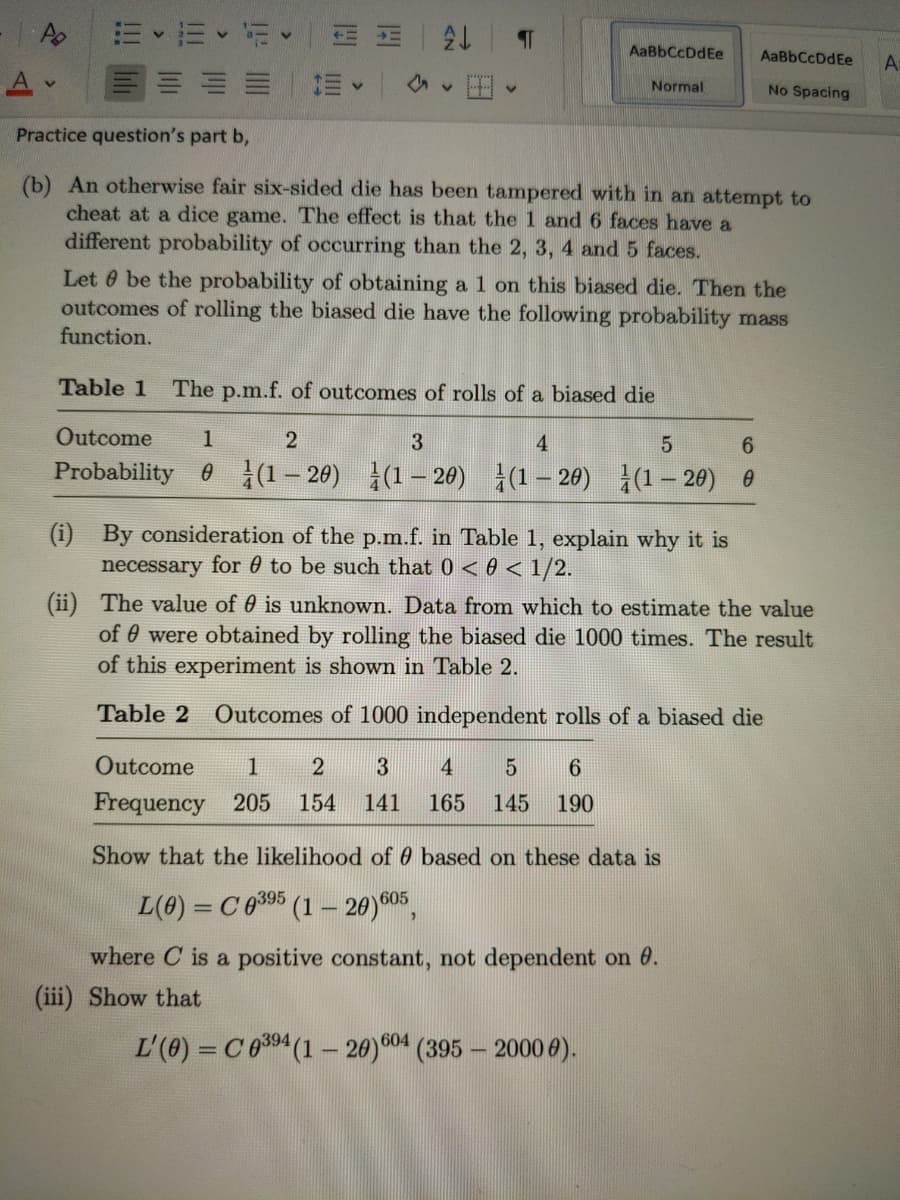Practice question's part b, (b) An otherwise fair six-sided die has been tampered with in an attempt to cheat at a dice game. The effect is that the 1 and 6 faces have a different probability of occurring than the 2, 3, 4 and 5 faces. Let 6 be the probability of obtaining a 1 on this biased die. Then the outcomes of rolling the biased die have the following probability mass function. Table 1 The p.m.f. of outcomes of rolls of a biased die Outcome 1 3 4 6. Probability 0 (1 – 20) |(1– 20) (1– 20) }(1– 20) 0 (i) By consideration of the p.m.f. in Table 1, explain why it is necessary for 0 to be such that 0 < 0 < 1/2. (ii) The value of 0 is unknown. Data from which to estimate the value of 0 were obtained by rolling the biased die 1000 times. The result of this experiment is shown in Table 2. Table 2 Outcomes of 1000 independent rolls of a biased die Outcome 1 2 4 6. Frequency 205 154 141 165 145 190 Show that the likelihood of 0 based on these data is L(6) = C0 05 (1 – 20)05, where C is a positive constant, not dependent on 0. (iii) Show that L'(0) = C 0394 (1 – 20)04 (395 – 2000 0).
Practice question's part b, (b) An otherwise fair six-sided die has been tampered with in an attempt to cheat at a dice game. The effect is that the 1 and 6 faces have a different probability of occurring than the 2, 3, 4 and 5 faces. Let 6 be the probability of obtaining a 1 on this biased die. Then the outcomes of rolling the biased die have the following probability mass function. Table 1 The p.m.f. of outcomes of rolls of a biased die Outcome 1 3 4 6. Probability 0 (1 – 20) |(1– 20) (1– 20) }(1– 20) 0 (i) By consideration of the p.m.f. in Table 1, explain why it is necessary for 0 to be such that 0 < 0 < 1/2. (ii) The value of 0 is unknown. Data from which to estimate the value of 0 were obtained by rolling the biased die 1000 times. The result of this experiment is shown in Table 2. Table 2 Outcomes of 1000 independent rolls of a biased die Outcome 1 2 4 6. Frequency 205 154 141 165 145 190 Show that the likelihood of 0 based on these data is L(6) = C0 05 (1 – 20)05, where C is a positive constant, not dependent on 0. (iii) Show that L'(0) = C 0394 (1 – 20)04 (395 – 2000 0).
College Algebra
7th Edition
ISBN:9781305115545
Author:James Stewart, Lothar Redlin, Saleem Watson
Publisher:James Stewart, Lothar Redlin, Saleem Watson
Chapter9: Counting And Probability
Section: Chapter Questions
Problem 3P: Dividing a Jackpot A game between two pIayers consists of tossing coin. Player A gets a point if the...
Related questions
Question
100%

Transcribed Image Text:AaBbCcDdEe
AaBbCcDdEe
A
A
Normal
No Spacing
Practice question's part b,
(b) An otherwise fair six-sided die has been tampered with in an attempt to
cheat at a dice game. The effect is that the 1 and 6 faces have a
different probability of occurring than the 2, 3, 4 and 5 faces.
Let 0 be the probability of obtaining a 1 on this biased die. Then the
outcomes of rolling the biased die have the following probability mass
function.
Table 1
The p.m.f. of outcomes of rolls of a biased die
Outcome
1
2
3
4
6
Probability 0 (1 – 20) (1– 20) (1– 20)
|(1– 20) 0
(i) By consideration of the p.m.f. in Table 1, explain why it is
necessary for 0 to be such that 0 < 0 < 1/2.
(ii) The value of 0 is unknown. Data from which to estimate the value
of 0 were obtained by rolling the biased die 1000 times. The result
of this experiment is shown in Table 2.
Table 2 Outcomes of 1000 independent rolls of a biased die
Outcome
1
3
4
6.
Frequency 205
154
141
165 145
190
Show that the likelihood of 0 based on these data is
L(e) = C0395 (1 – 20)605,
where C is a positive constant, not dependent on 0.
(iii) Show that
L'(0) = C 0394 (1 – 20)04 (395 – 2000 0).
Expert Solution
This question has been solved!
Explore an expertly crafted, step-by-step solution for a thorough understanding of key concepts.
This is a popular solution!
Trending now
This is a popular solution!
Step by step
Solved in 2 steps with 2 images

Recommended textbooks for you

College Algebra
Algebra
ISBN:
9781305115545
Author:
James Stewart, Lothar Redlin, Saleem Watson
Publisher:
Cengage Learning

Algebra & Trigonometry with Analytic Geometry
Algebra
ISBN:
9781133382119
Author:
Swokowski
Publisher:
Cengage

College Algebra
Algebra
ISBN:
9781305115545
Author:
James Stewart, Lothar Redlin, Saleem Watson
Publisher:
Cengage Learning

Algebra & Trigonometry with Analytic Geometry
Algebra
ISBN:
9781133382119
Author:
Swokowski
Publisher:
Cengage